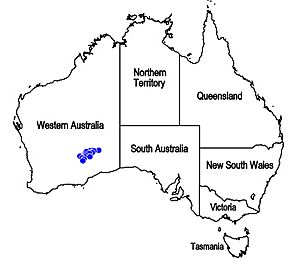Dicrastylis cundeeleensis facts for kids
Quick facts for kids Dicrastylis cundeeleensis |
|
|---|---|
| Conservation status | |
| Scientific classification | |
 |
Dicrastylis cundeeleensis is a special kind of flowering plant. It belongs to the Dicrastylis group and is part of the Lamiaceae family. This plant is found only in the southern part of Western Australia. This means it is "endemic" to that area.
What Does It Look Like?
Dicrastylis cundeeleensis is a small, woolly shrub. It usually grows between 20 cm and 50 cm tall. You can find it growing in sandy areas, often in yellow or reddish-yellow sand.
Its stems are mostly round. They do not have any special flat, scale-like hairs. The leaves grow opposite each other on the stem. They are 4–25 mm long and 1.3-3.5 mm wide. The leaves have branched hairs, which look a bit like tiny trees. Their surface also looks bumpy or puckered.
The plant has small flowers. The flower stalks are 1.5-2 mm long. They have both branched hairs and flat, scale-like hairs. The calyx, which is the outer part of the flower, has five parts. It is covered in branched hairs. The petals are white or cream-colored and are 3.5-6 mm long. They do not have any dots or stripes inside. Each flower has five stamens, which are the parts that produce pollen. You might see these flowers in January, June, October, or November.
Sometimes, this plant can mix with another similar species called D. brunnea. When this happens, they can create a new plant that is a mix of both. This is called a hybrid.
How Was It Named?
This plant was first officially described in 2007. The person who described it was a scientist named Barbara Lynette Rye. She gave it the name Dicrastylis cundeeleensis.
The second part of its name, cundeeleensis, tells us where it comes from. It means "from Cundeelee." This refers to the Cundeelee area in Western Australia, where the plant is found. There are no other scientific names for this plant.


